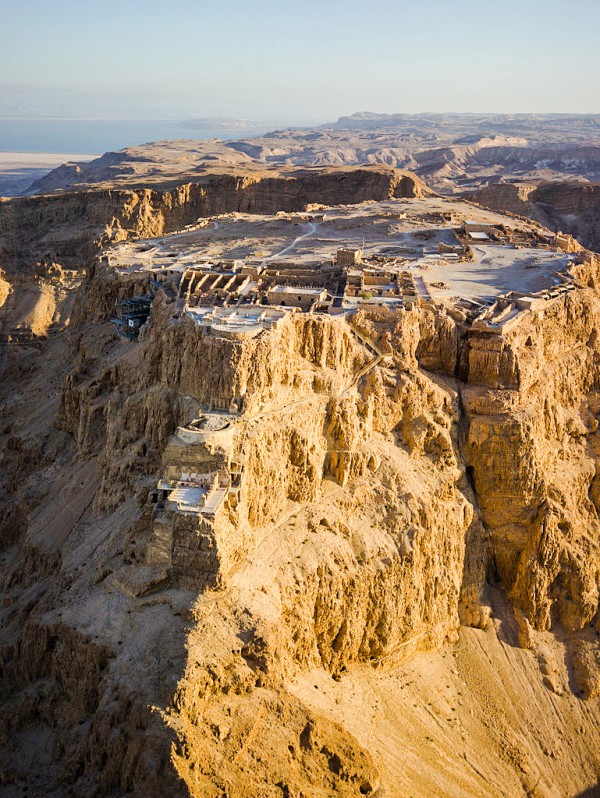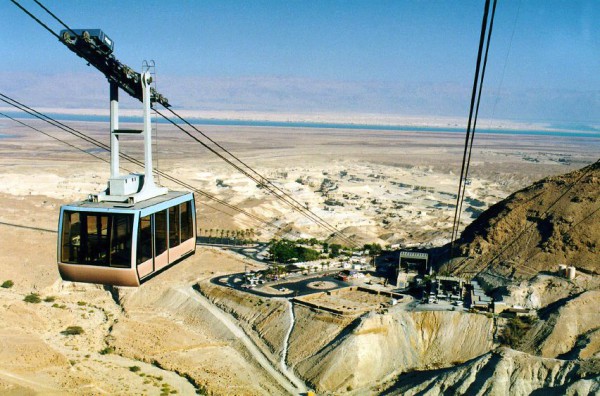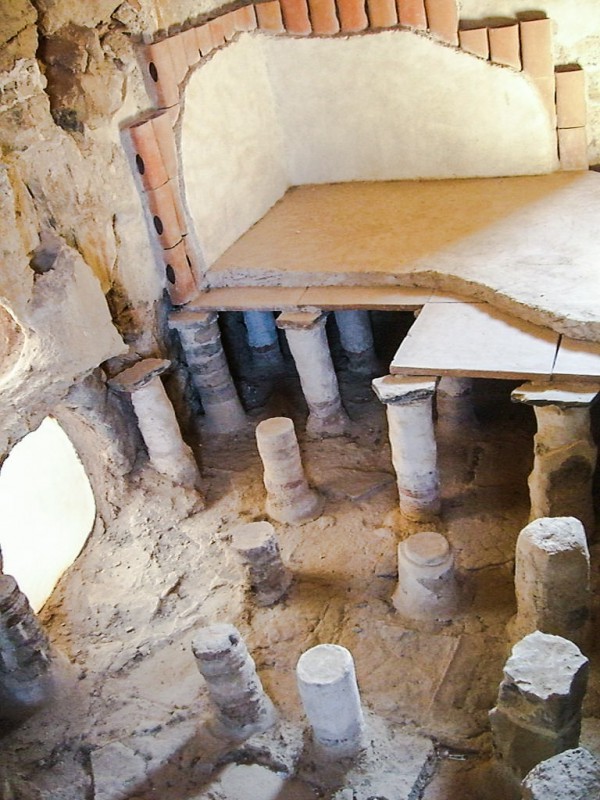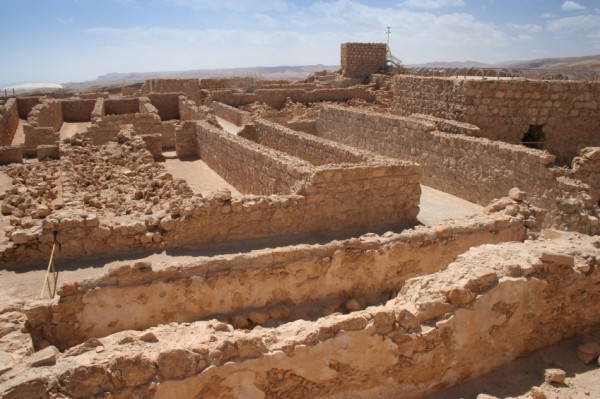Israel’s second most popular paid tourist attraction is a remote masterpiece of ancient ruins that have remained virtually inaccessible for about two millennia.
Today, these ruins, called Masada (מצדה), which are located about 35 miles south of Jerusalem on the eastern edge of the Judean Desert, are one of the Jewish People’s greatest symbols of gritty determination.
The ruins were originally a fortress palace built between 37 and 31 BC by Herod the Great atop a high, isolated rock plateau overlooking the Dead Sea, but they also saw a tragic story played out within their walls.
This nearly impregnable fortress served as the last stand for an extremist group of Jewish Zealots who fled there with their families following the fall of Jerusalem and destruction of the Second Temple in AD 70.
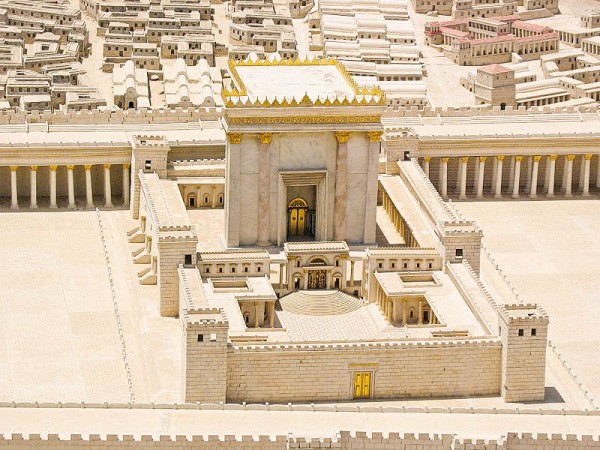
The Great Revolt of the Jews against Rome in AD 66 led to one of the greatest catastrophes of the Jewish People—the destruction of the Second Temple.
“The LORD will surely comfort Zion and will look with compassion on all her ruins; He will make her deserts like Eden, her wastelands like the garden of the LORD. Joy and gladness will be found in her, thanksgiving and the sound of singing.” (Isaiah 51:3)
Herod’s Fortified Palace in the Desert
Masada, which looms straight up in the desert, is an imposing, remote site.
With sheer cliffs rising 1,300 feet (400 meters) over the Dead Sea on the east and 300 feet (91 meters) on the west, it appears impenetrable.
The rhomboid-shaped plateau on top of Masada is flat, covering about 1,300 feet (400 meters) by 1969 feet (600 meters). (Israel Nature and Parks Authority)
To further fortify this lofty stronghold, Herod built a surrounding wall totaling 4,600 feet (1.4 kilometers) long and 13 feet (4 meters) wide, punctuated by a series of towers.

This model on Masada helps tourists to visualize what the ruins they are exploring once looked like.
Herod also built large and small palaces, barracks for the guards, bathhouses, a swimming pool, 29 storerooms for food and drink—each one 89 feet long (27 meters)—and 12 gigantic, rock-hewn cisterns with a total capacity of some 40,000 cubic meters to collect rain water. (One cubic meter equals 264 US gallons.)
Three winding paths led up to Masada’s fortified gates.
Today tourists can reach the top on foot by one of these challenging, ancient paths.
A cable car is also available to carry those who want to conserve their strength for exploring the impressive mountaintop ruins.
Those who visit Masada are greeted with many fascinating sites, including the remains of Herod’s palace on the northern face of the mountain.
A wall separates it from the fortress allowing for both privacy and security.
The palace consists of three terraces with living quarters on the upper terrace, complete with a balcony and rooms with black and white mosaic-tiled floors.
Below this are two lower terraces used for entertainment and relaxation, with a central courtyard on the middle terrace and another on the lower.
Both courtyards were surrounded by fluted columns and featured frescoes with multicolored geometric shapes and painted imitations of cut marble.
An elaborately-built bathhouse contained a steam room (caldarium) with a suspended floor supported by rows of low pillars through which hot air was blown to raise the temperature.
A second Western Palace probably served as an administrative center.
It covered over an acre (4,000 square meters) and included storerooms, offices, and a large royal apartment.
Several rooms had splendidly designed mosaic floors.
“Proclaim further: This is what the LORD Almighty says: ‘My towns will again overflow with prosperity, and the LORD will again comfort Zion and choose Jerusalem.'” (Zechariah 1:17)
Epic Rebellion in the Desert
For the last two millennia, Masada remained all but forgotten by the Jewish People.
Most of our knowledge about this fortress is derived from excavations during the 1960s by the famous Israeli archaeologist Yigael Yadin, as well as the account given by the Roman-Jewish historian Flavius Josephus.
In his book The Jewish Wars, Josephus states that as many as 960 Jewish rebels and their families committed mass suicide on Masada at the end of the First Jewish-Roman War (AD 66–73), rather than surrender to the Roman forces determined to capture each one of them.
However, historically speaking, the Jewish People ignored the writings of Josephus because of his defection to the Romans after the fall of Jerusalem.
It was only in the 1920s when the Hebrew writer Isaac Lamdan wrote the poem “Masada,” which describes the fight of the Jewish People against all enemies, that Josephus’ account gained attention.
Moreover, the survivors of the Warsaw Ghetto Uprising, in which Jewish fighters stood in opposition to the German army in World War II, revealed that they were inspired by Lamdan’s poem to fight the Germans despite the overwhelming odds against their victory. (Jewish Virtual Library)

The Siege and Destruction of Jerusalem by the Romans Under the Command of Titus, by David Roberts. Although over a million people were killed during the siege of Jerusalem and many of the rebels were sold into slavery or scattered, pockets of Jewish resistance to Roman domination remained.
Josephus reported that two women and five small children were the only survivors of the mass suicide atop Masada.
They were taken captive by the Romans who entered the fortress by means of a battering ram and siege tower that were laboriously moved up a constructed ramp.
The accounts of those survivors form the basis for the version of history in The Jewish Wars, which states that the Zealot leader Elazar Ben-Yair persuaded the heads of families to draw lots to kill their wives, children, and themselves rather than allow them to be captured and even tortured by the Romans.
“Since we long ago resolved never to be servants to the Romans, nor to any other than to God Himself, Who alone is the true and just Lord of mankind, the time is now come that obliges us to make that resolution true in practice…. We were the very first that revolted, and we are the last to fight against them; and I cannot but esteem it as a favor that God has granted us, that it is still in our power to die bravely, and in a state of freedom,” Elazar Ben-Yair told those trapped atop Masada. (The Jewish Wars)

Ruins of Herod’s northern palace on Masada: Although the site of Masada was identified in the mid-1800s, it was not excavated until the 1960s
The Overthrow of Masada
“They will fall by the sword and will be taken as prisoners to all the nations. Jerusalem will be trampled on by the Gentiles until the times of the Gentiles are fulfilled.” (Luke 21:24)
In The Jewish Wars, Josephus says that a group of Jewish rebels called Sicarii (a splinter group of rebels) overcame the Roman garrison at Masada at the beginning of the Jewish revolt against Rome in AD 66, more than 60 years after the death of Herod.
With the destruction of the Temple and the fall of Jerusalem, this group was joined by other rebels and their families, who fled the city.
From Masada, they resisted the Romans for another three years, raiding surrounding communities for stores and supplies. (Jewish Virtual Library)

A winding foot path leads up to Masada. If you look closely, you can see at the base of the mountain, the outline of rectangular Roman siege camps (top of the photo).
The rebels put to use the synagogue built by Herod on Masada, and fragments of two Bible scrolls were found there—portions of the book of Deuteronomy and the section from Ezekiel 37 describing the “valley of dry bones.”
This is what the Sovereign Lord says to these bones: I will make breath enter you, and you will come to life. I will attach tendons to you and make flesh come upon you and cover you with skin; I will put breath in you, and you will come to life. Then you will know that I am the Lord. (Ezekiel 37:5–6)
The synagogue’s 1,410 square foot hall faces toward Jerusalem and forms a part of the northwestern portion of the surrounding wall.
The rebel community added four tiers of plaster benches along the walls as well as columns to support the ceiling.
Today, this synagogue is considered the best example of first century synagogues predating the destruction of the Temple.
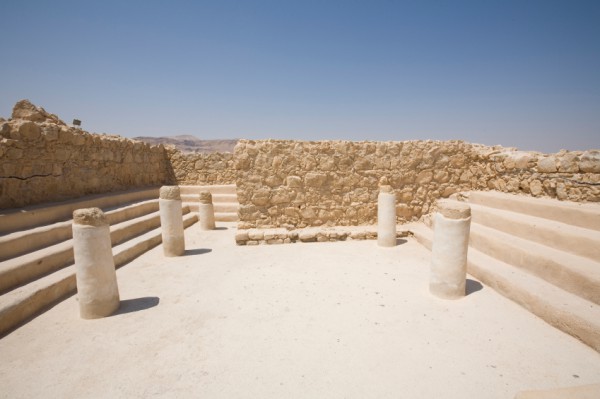
The synagogue on Masada dates from the time of the Second Temple and is likely the oldest synagogue in the world.
Breaking Jewish Resistance
On a mission to end Jewish resistance, Roman Governor Lucius Flavius Silva laid siege to the fortress in AD 73 with his Tenth Legion, along with a work crew of thousands of Jewish prisoners.
The outlines of the camps at the base of the mountain and the earthworks of a Roman assault ramp on Masada’s west side, which were constructed during the Siege of Masada (AD 73–74), can still be seen today.
It is believed that Jewish slave labor was used to construct the ramp to deter the rebels from attacking the laborers during its construction.
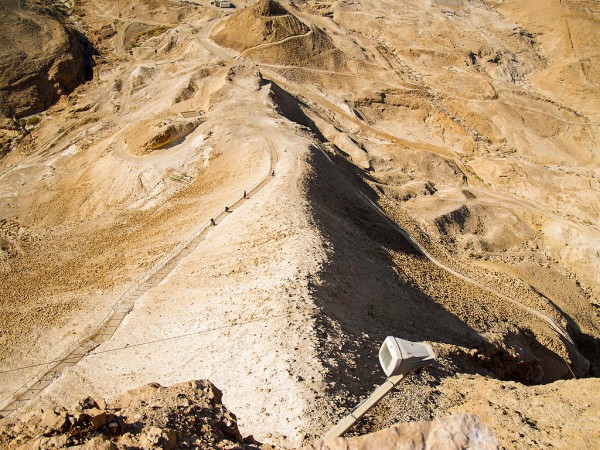
Silva’s ramp, built with many thousands of tons of compacted rock and earth, is still visible today.
In the spring of AD 74, the Romans moved the battering ram up the ramp and set the gate on fire.
It is said that the rebels prayed for God to change the direction of the wind so that the fire would die down, and when this did not happen, they submitted themselves to His will.
It was at this point that Ben-Yair called on the Jewish defenders to sacrifice their lives through a mass suicide.
Archaeologist Yadin found evidence that the rebels had enough supplies to hold out longer.
He uncovered a storehouse that had the remains of a large number of storage jars, which originally contained large quantities of oil, wine, grains and other foodstuffs.
The rebels, however, chose suicide rather than surrender and witness their wives and children being taken as slaves by the Roman forces.
Josephus tells us that the Zealots burned everything except the food to send a message to the Romans that they were not driven to suicide by hunger.
They cast lots to select 10 men to kill the others. Then one man was selected to kill the remaining nine plus himself.
Eleven potsherds were uncovered in the ruins, one of which bears the name “Ben Yair.”
It is believed that the other ten are inscribed with the names of the last ten who were chosen to kill the others and then themselves.
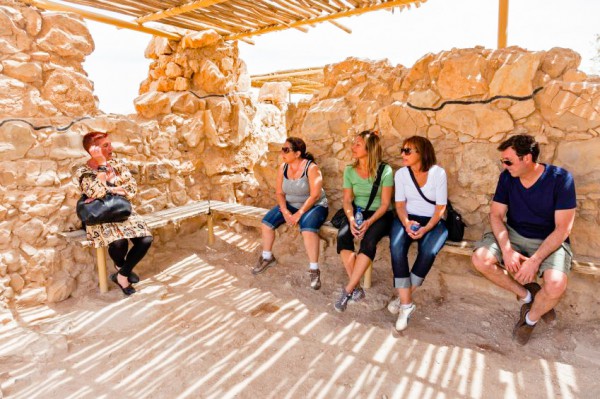
A tour group sits in a partially restored building on Masada, listening intently as their guide explains the historic events that took place there in ancient times.
A National Symbol of Courage
“I, even I, am He who comforts you. Who are you that you fear mere mortals, human beings who are but grass?” (Isaiah 51:12)
Although it is almost 2,000 years since Masada fell to the Romans, the death of these 1,000 lives still has importance for many Israelis.
Today, Masada stands as a symbol of national courage and fortitude.
In the face of international anti-Israel and anti-Semitic forces and events such as the Holocaust, many Israelis have been inspired by the Zealots’ determination to resist domination at all costs, although many other Israelis associate their mass suicide with fanaticism.
Moreover, both murdering one’s family and suicide are forbidden in Judaism.

A military ceremony held at the base of Masada: Soldiers who are being sworn-in climb to the top of Masada on the winding Snake Path for a torch-lit ceremony that is held at night.
Moshe Dayan, the Chief of Staff of the Israel Defense Forces (IDF), was so stirred by the resolve of the Zealots that he established the tradition of holding at Masada the swearing-in ceremony for soldiers who have completed Israel Defense Forces basic training.
That ceremony ends with the affirmation “Masada shall not fall again.”
While it looked like the end of the road for the Jewish People when Jerusalem fell to Rome and the Temple was destroyed 2,000 years ago, in reality, God had not abandoned His people.
“For the Lord your God is a merciful God; He will not abandon or destroy you or forget the covenant with your ancestors, which He confirmed to them by oath.” (Deuteronomy 4:31)
Miraculously, against all natural odds and in fulfillment of countless Bible prophecies, Israel became an independent state once again in 1948. (Isaiah 11:11; Amos 9:14–15)
The modern-day State of Israel is a precursor to the rebuilding of the Temple, the national salvation of the Jewish People, the return of Yeshua (Jesus) and the establishment of His Kingdom on the earth.




